Data and Information Security: Analysis of Data Breaches Report
VerifiedAdded on 2020/02/24
|10
|2377
|257
Report
AI Summary
This report offers an in-depth analysis of two significant data breaches: the Bronx-Lebanon Hospital Center data breach and the May 2017 WannaCry ransomware cyber-attack. Part A details the Bronx-Lebanon Hospital breach, explaining how the breach occurred due to a vulnerable Rsync backup server managed by a third-party vendor, exposing patient records. It explores the reasons behind the breach, including the healthcare industry's appeal to hackers due to the volume of sensitive personal and financial data stored. The report then proposes possible solutions, such as securing computer systems, employee training, updating security procedures, encrypting data, and implementing two-factor authentication and intrusion detection systems. Part B focuses on the WannaCry ransomware attack, describing its global impact, including the encryption of data across numerous countries and its spread through a flaw in the Microsoft Windows operating system. The report outlines the attack's impact, affecting various sectors, including healthcare, and the measures that could have prevented the attack, such as software patches and securing computer network systems. The conclusion emphasizes the increasing importance of cybersecurity in the face of emerging technologies and cyber threats, urging organizations to prioritize data security through comprehensive policies, employee training, and investment in security measures.
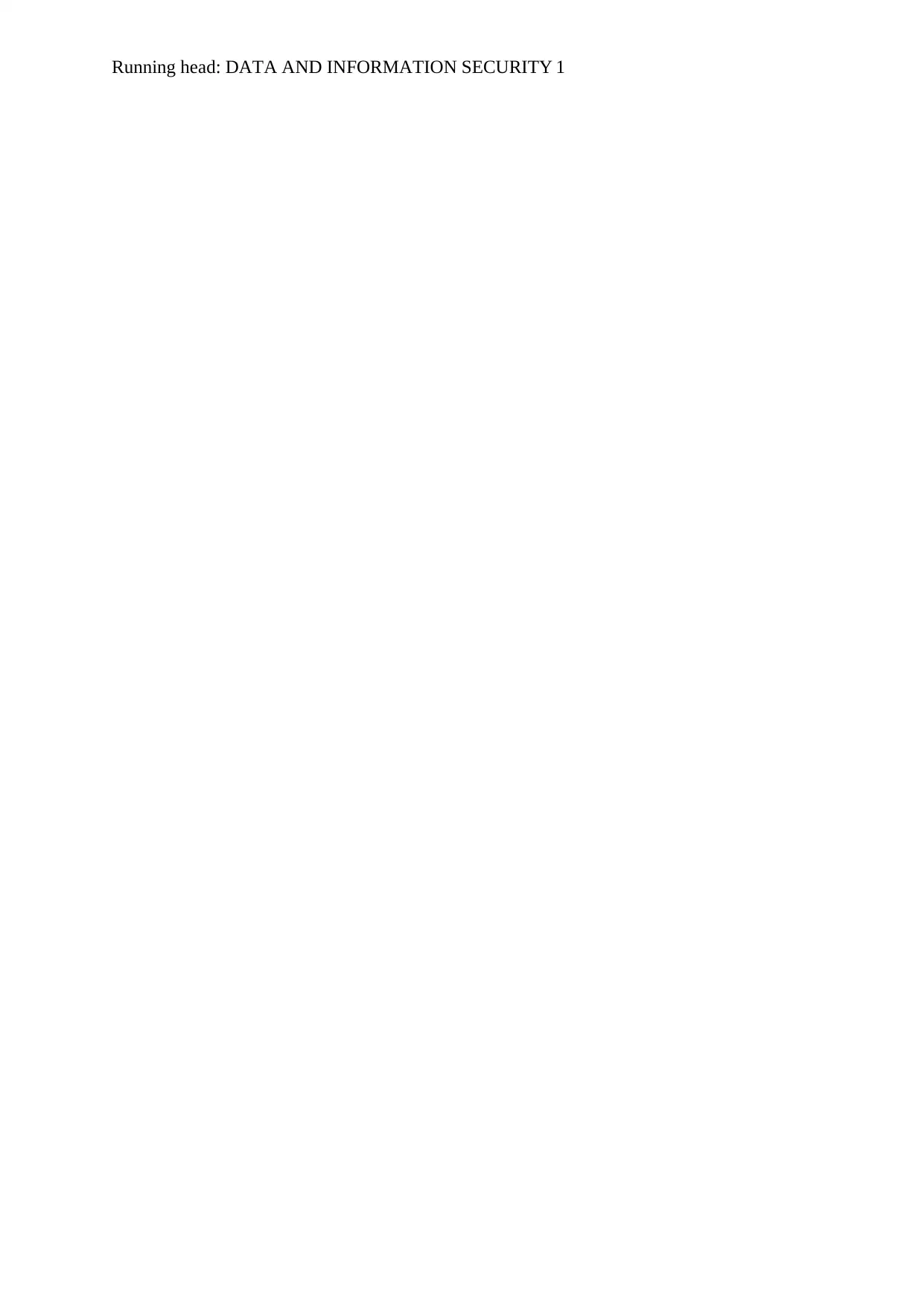
Running head: DATA AND INFORMATION SECURITY 1
Paraphrase This Document
Need a fresh take? Get an instant paraphrase of this document with our AI Paraphraser
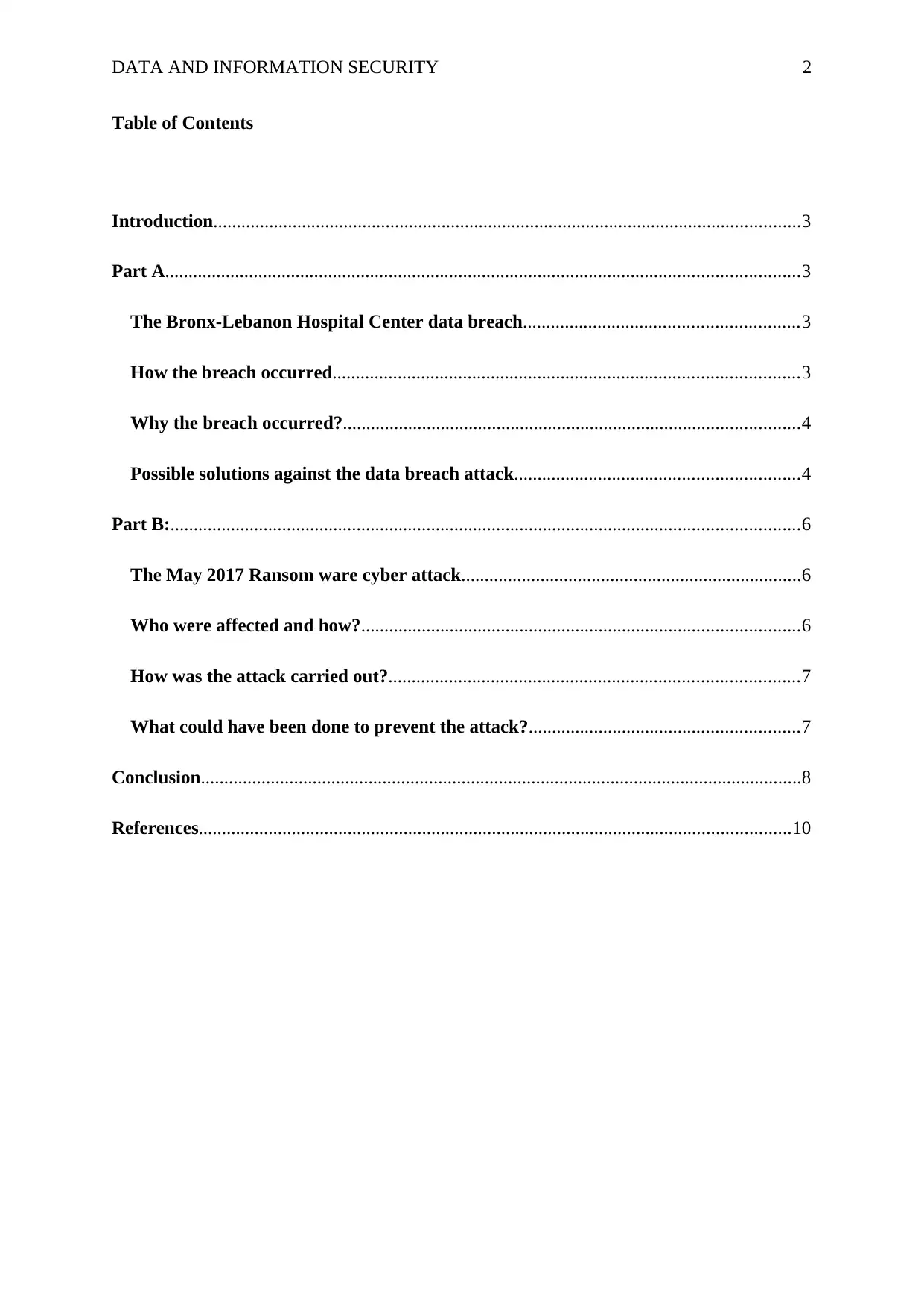
DATA AND INFORMATION SECURITY 2
Table of Contents
Introduction..............................................................................................................................3
Part A........................................................................................................................................3
The Bronx-Lebanon Hospital Center data breach...........................................................3
How the breach occurred....................................................................................................3
Why the breach occurred?..................................................................................................4
Possible solutions against the data breach attack.............................................................4
Part B:.......................................................................................................................................6
The May 2017 Ransom ware cyber attack.........................................................................6
Who were affected and how?..............................................................................................6
How was the attack carried out?........................................................................................7
What could have been done to prevent the attack?..........................................................7
Conclusion.................................................................................................................................8
References...............................................................................................................................10
Table of Contents
Introduction..............................................................................................................................3
Part A........................................................................................................................................3
The Bronx-Lebanon Hospital Center data breach...........................................................3
How the breach occurred....................................................................................................3
Why the breach occurred?..................................................................................................4
Possible solutions against the data breach attack.............................................................4
Part B:.......................................................................................................................................6
The May 2017 Ransom ware cyber attack.........................................................................6
Who were affected and how?..............................................................................................6
How was the attack carried out?........................................................................................7
What could have been done to prevent the attack?..........................................................7
Conclusion.................................................................................................................................8
References...............................................................................................................................10
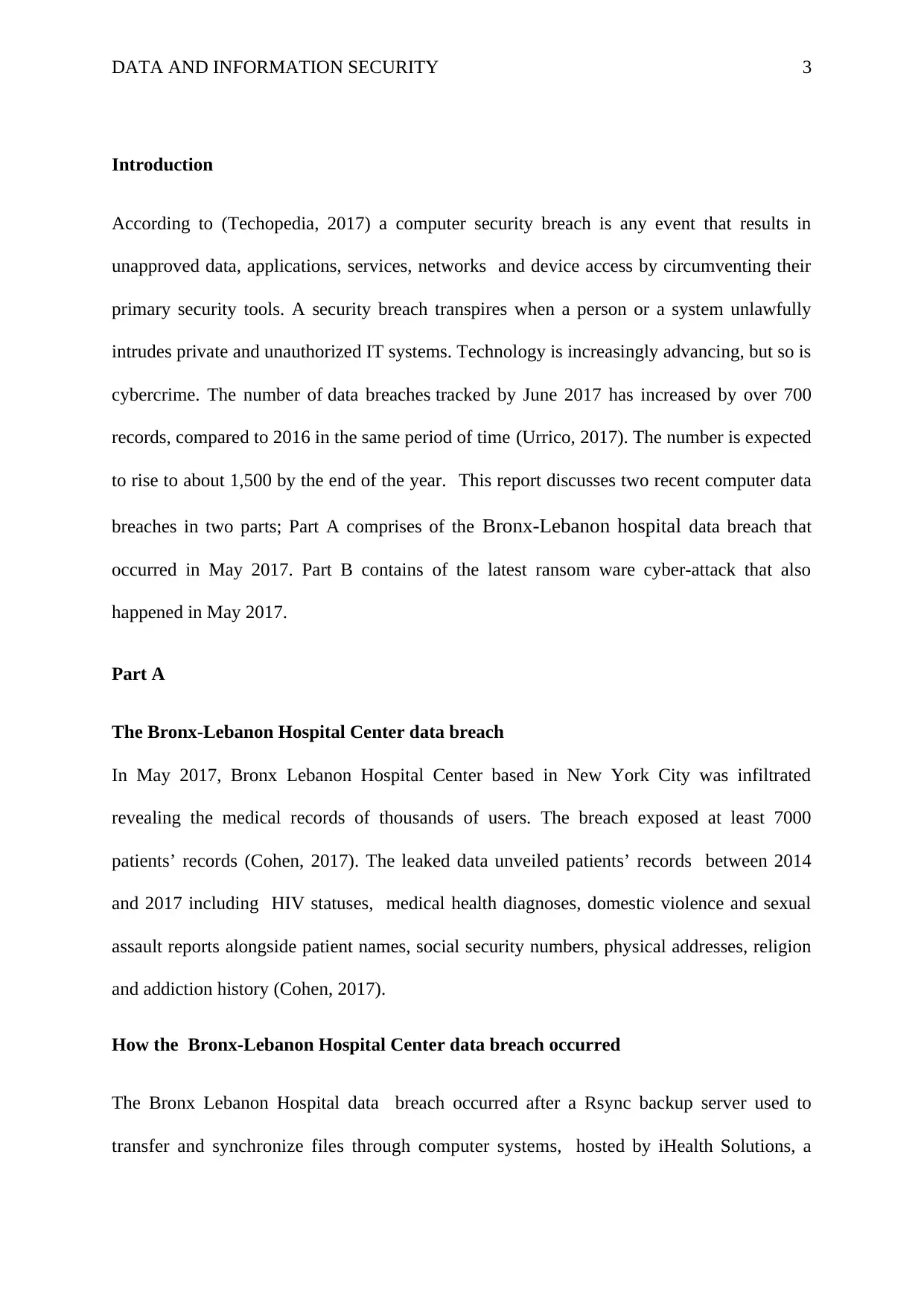
DATA AND INFORMATION SECURITY 3
Introduction
According to (Techopedia, 2017) a computer security breach is any event that results in
unapproved data, applications, services, networks and device access by circumventing their
primary security tools. A security breach transpires when a person or a system unlawfully
intrudes private and unauthorized IT systems. Technology is increasingly advancing, but so is
cybercrime. The number of data breaches tracked by June 2017 has increased by over 700
records, compared to 2016 in the same period of time (Urrico, 2017). The number is expected
to rise to about 1,500 by the end of the year. This report discusses two recent computer data
breaches in two parts; Part A comprises of the Bronx-Lebanon hospital data breach that
occurred in May 2017. Part B contains of the latest ransom ware cyber-attack that also
happened in May 2017.
Part A
The Bronx-Lebanon Hospital Center data breach
In May 2017, Bronx Lebanon Hospital Center based in New York City was infiltrated
revealing the medical records of thousands of users. The breach exposed at least 7000
patients’ records (Cohen, 2017). The leaked data unveiled patients’ records between 2014
and 2017 including HIV statuses, medical health diagnoses, domestic violence and sexual
assault reports alongside patient names, social security numbers, physical addresses, religion
and addiction history (Cohen, 2017).
How the Bronx-Lebanon Hospital Center data breach occurred
The Bronx Lebanon Hospital data breach occurred after a Rsync backup server used to
transfer and synchronize files through computer systems, hosted by iHealth Solutions, a
Introduction
According to (Techopedia, 2017) a computer security breach is any event that results in
unapproved data, applications, services, networks and device access by circumventing their
primary security tools. A security breach transpires when a person or a system unlawfully
intrudes private and unauthorized IT systems. Technology is increasingly advancing, but so is
cybercrime. The number of data breaches tracked by June 2017 has increased by over 700
records, compared to 2016 in the same period of time (Urrico, 2017). The number is expected
to rise to about 1,500 by the end of the year. This report discusses two recent computer data
breaches in two parts; Part A comprises of the Bronx-Lebanon hospital data breach that
occurred in May 2017. Part B contains of the latest ransom ware cyber-attack that also
happened in May 2017.
Part A
The Bronx-Lebanon Hospital Center data breach
In May 2017, Bronx Lebanon Hospital Center based in New York City was infiltrated
revealing the medical records of thousands of users. The breach exposed at least 7000
patients’ records (Cohen, 2017). The leaked data unveiled patients’ records between 2014
and 2017 including HIV statuses, medical health diagnoses, domestic violence and sexual
assault reports alongside patient names, social security numbers, physical addresses, religion
and addiction history (Cohen, 2017).
How the Bronx-Lebanon Hospital Center data breach occurred
The Bronx Lebanon Hospital data breach occurred after a Rsync backup server used to
transfer and synchronize files through computer systems, hosted by iHealth Solutions, a
⊘ This is a preview!⊘
Do you want full access?
Subscribe today to unlock all pages.

Trusted by 1+ million students worldwide
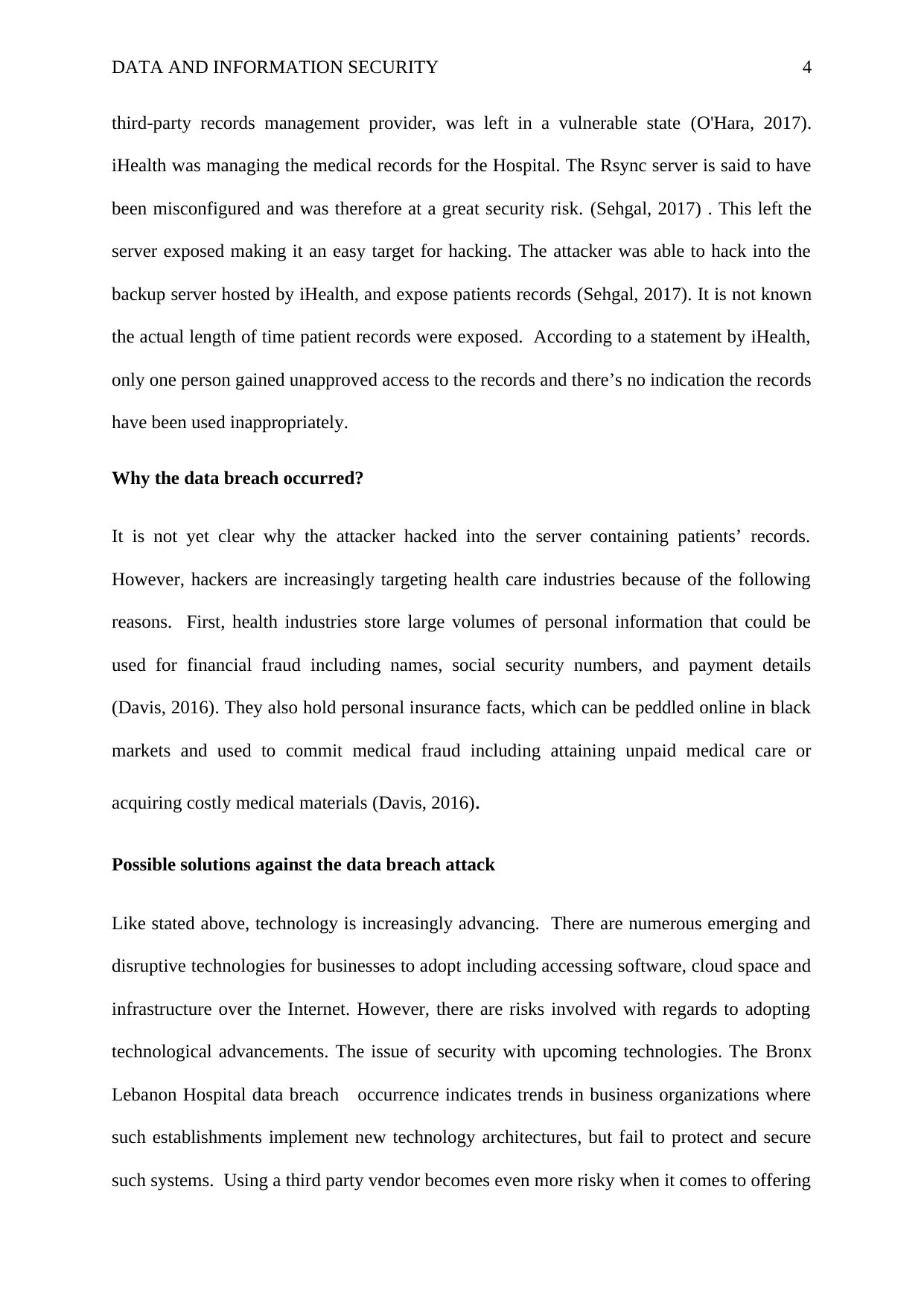
DATA AND INFORMATION SECURITY 4
third-party records management provider, was left in a vulnerable state (O'Hara, 2017).
iHealth was managing the medical records for the Hospital. The Rsync server is said to have
been misconfigured and was therefore at a great security risk. (Sehgal, 2017) . This left the
server exposed making it an easy target for hacking. The attacker was able to hack into the
backup server hosted by iHealth, and expose patients records (Sehgal, 2017). It is not known
the actual length of time patient records were exposed. According to a statement by iHealth,
only one person gained unapproved access to the records and there’s no indication the records
have been used inappropriately.
Why the data breach occurred?
It is not yet clear why the attacker hacked into the server containing patients’ records.
However, hackers are increasingly targeting health care industries because of the following
reasons. First, health industries store large volumes of personal information that could be
used for financial fraud including names, social security numbers, and payment details
(Davis, 2016). They also hold personal insurance facts, which can be peddled online in black
markets and used to commit medical fraud including attaining unpaid medical care or
acquiring costly medical materials (Davis, 2016).
Possible solutions against the data breach attack
Like stated above, technology is increasingly advancing. There are numerous emerging and
disruptive technologies for businesses to adopt including accessing software, cloud space and
infrastructure over the Internet. However, there are risks involved with regards to adopting
technological advancements. The issue of security with upcoming technologies. The Bronx
Lebanon Hospital data breach occurrence indicates trends in business organizations where
such establishments implement new technology architectures, but fail to protect and secure
such systems. Using a third party vendor becomes even more risky when it comes to offering
third-party records management provider, was left in a vulnerable state (O'Hara, 2017).
iHealth was managing the medical records for the Hospital. The Rsync server is said to have
been misconfigured and was therefore at a great security risk. (Sehgal, 2017) . This left the
server exposed making it an easy target for hacking. The attacker was able to hack into the
backup server hosted by iHealth, and expose patients records (Sehgal, 2017). It is not known
the actual length of time patient records were exposed. According to a statement by iHealth,
only one person gained unapproved access to the records and there’s no indication the records
have been used inappropriately.
Why the data breach occurred?
It is not yet clear why the attacker hacked into the server containing patients’ records.
However, hackers are increasingly targeting health care industries because of the following
reasons. First, health industries store large volumes of personal information that could be
used for financial fraud including names, social security numbers, and payment details
(Davis, 2016). They also hold personal insurance facts, which can be peddled online in black
markets and used to commit medical fraud including attaining unpaid medical care or
acquiring costly medical materials (Davis, 2016).
Possible solutions against the data breach attack
Like stated above, technology is increasingly advancing. There are numerous emerging and
disruptive technologies for businesses to adopt including accessing software, cloud space and
infrastructure over the Internet. However, there are risks involved with regards to adopting
technological advancements. The issue of security with upcoming technologies. The Bronx
Lebanon Hospital data breach occurrence indicates trends in business organizations where
such establishments implement new technology architectures, but fail to protect and secure
such systems. Using a third party vendor becomes even more risky when it comes to offering
Paraphrase This Document
Need a fresh take? Get an instant paraphrase of this document with our AI Paraphraser
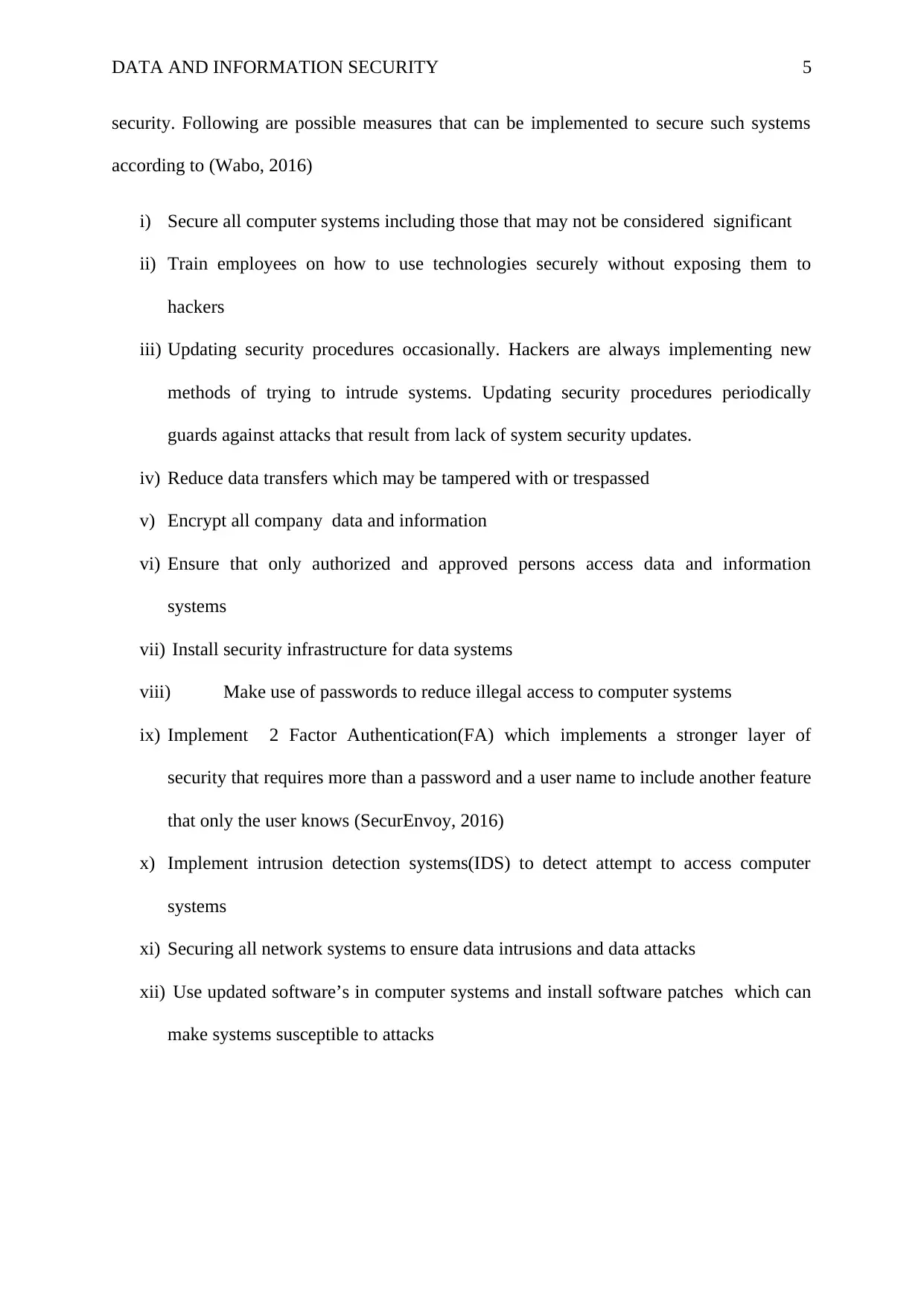
DATA AND INFORMATION SECURITY 5
security. Following are possible measures that can be implemented to secure such systems
according to (Wabo, 2016)
i) Secure all computer systems including those that may not be considered significant
ii) Train employees on how to use technologies securely without exposing them to
hackers
iii) Updating security procedures occasionally. Hackers are always implementing new
methods of trying to intrude systems. Updating security procedures periodically
guards against attacks that result from lack of system security updates.
iv) Reduce data transfers which may be tampered with or trespassed
v) Encrypt all company data and information
vi) Ensure that only authorized and approved persons access data and information
systems
vii) Install security infrastructure for data systems
viii) Make use of passwords to reduce illegal access to computer systems
ix) Implement 2 Factor Authentication(FA) which implements a stronger layer of
security that requires more than a password and a user name to include another feature
that only the user knows (SecurEnvoy, 2016)
x) Implement intrusion detection systems(IDS) to detect attempt to access computer
systems
xi) Securing all network systems to ensure data intrusions and data attacks
xii) Use updated software’s in computer systems and install software patches which can
make systems susceptible to attacks
security. Following are possible measures that can be implemented to secure such systems
according to (Wabo, 2016)
i) Secure all computer systems including those that may not be considered significant
ii) Train employees on how to use technologies securely without exposing them to
hackers
iii) Updating security procedures occasionally. Hackers are always implementing new
methods of trying to intrude systems. Updating security procedures periodically
guards against attacks that result from lack of system security updates.
iv) Reduce data transfers which may be tampered with or trespassed
v) Encrypt all company data and information
vi) Ensure that only authorized and approved persons access data and information
systems
vii) Install security infrastructure for data systems
viii) Make use of passwords to reduce illegal access to computer systems
ix) Implement 2 Factor Authentication(FA) which implements a stronger layer of
security that requires more than a password and a user name to include another feature
that only the user knows (SecurEnvoy, 2016)
x) Implement intrusion detection systems(IDS) to detect attempt to access computer
systems
xi) Securing all network systems to ensure data intrusions and data attacks
xii) Use updated software’s in computer systems and install software patches which can
make systems susceptible to attacks
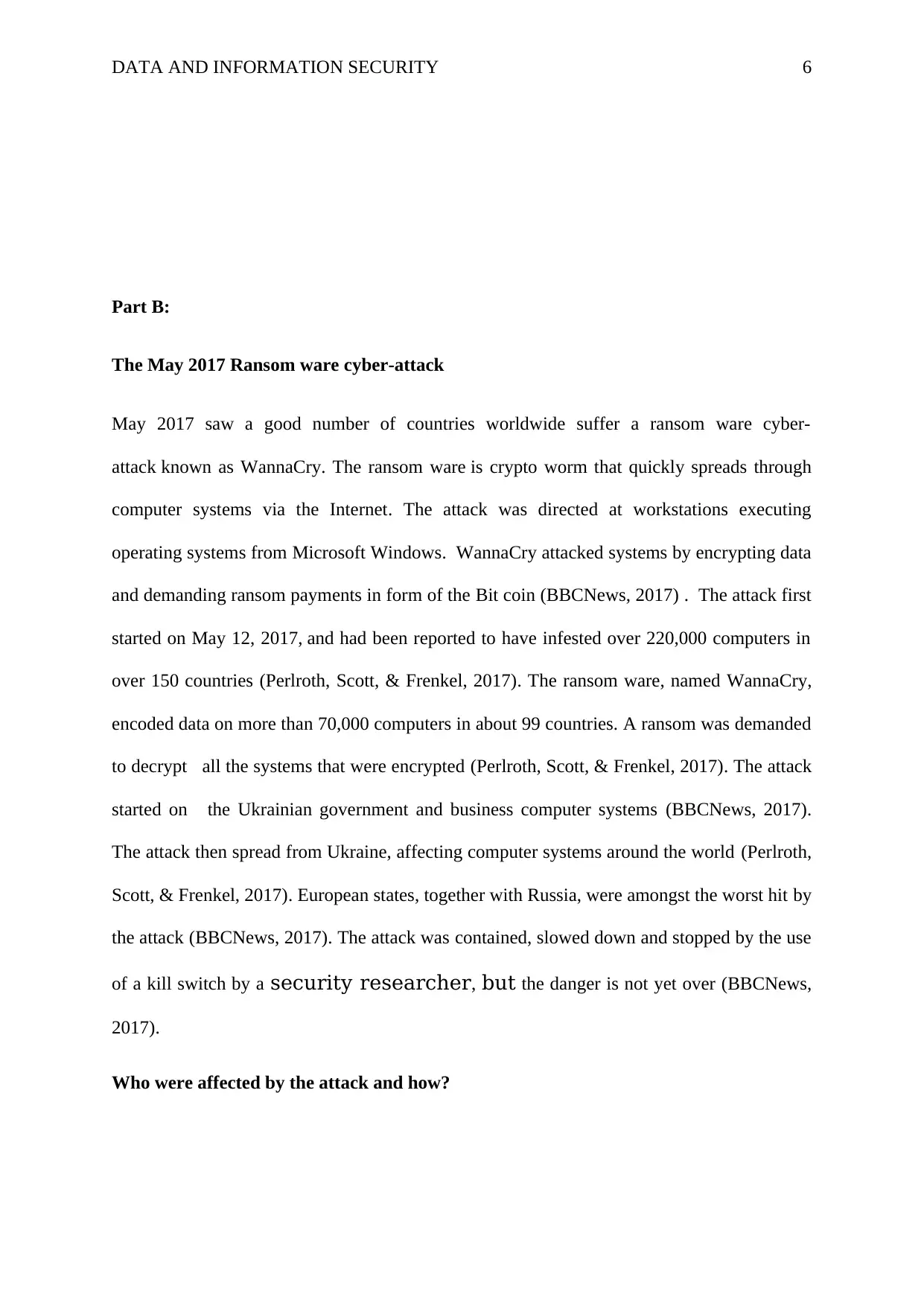
DATA AND INFORMATION SECURITY 6
Part B:
The May 2017 Ransom ware cyber-attack
May 2017 saw a good number of countries worldwide suffer a ransom ware cyber-
attack known as WannaCry. The ransom ware is crypto worm that quickly spreads through
computer systems via the Internet. The attack was directed at workstations executing
operating systems from Microsoft Windows. WannaCry attacked systems by encrypting data
and demanding ransom payments in form of the Bit coin (BBCNews, 2017) . The attack first
started on May 12, 2017, and had been reported to have infested over 220,000 computers in
over 150 countries (Perlroth, Scott, & Frenkel, 2017). The ransom ware, named WannaCry,
encoded data on more than 70,000 computers in about 99 countries. A ransom was demanded
to decrypt all the systems that were encrypted (Perlroth, Scott, & Frenkel, 2017). The attack
started on the Ukrainian government and business computer systems (BBCNews, 2017).
The attack then spread from Ukraine, affecting computer systems around the world (Perlroth,
Scott, & Frenkel, 2017). European states, together with Russia, were amongst the worst hit by
the attack (BBCNews, 2017). The attack was contained, slowed down and stopped by the use
of a kill switch by a security researcher, but the danger is not yet over (BBCNews,
2017).
Who were affected by the attack and how?
Part B:
The May 2017 Ransom ware cyber-attack
May 2017 saw a good number of countries worldwide suffer a ransom ware cyber-
attack known as WannaCry. The ransom ware is crypto worm that quickly spreads through
computer systems via the Internet. The attack was directed at workstations executing
operating systems from Microsoft Windows. WannaCry attacked systems by encrypting data
and demanding ransom payments in form of the Bit coin (BBCNews, 2017) . The attack first
started on May 12, 2017, and had been reported to have infested over 220,000 computers in
over 150 countries (Perlroth, Scott, & Frenkel, 2017). The ransom ware, named WannaCry,
encoded data on more than 70,000 computers in about 99 countries. A ransom was demanded
to decrypt all the systems that were encrypted (Perlroth, Scott, & Frenkel, 2017). The attack
started on the Ukrainian government and business computer systems (BBCNews, 2017).
The attack then spread from Ukraine, affecting computer systems around the world (Perlroth,
Scott, & Frenkel, 2017). European states, together with Russia, were amongst the worst hit by
the attack (BBCNews, 2017). The attack was contained, slowed down and stopped by the use
of a kill switch by a security researcher, but the danger is not yet over (BBCNews,
2017).
Who were affected by the attack and how?
⊘ This is a preview!⊘
Do you want full access?
Subscribe today to unlock all pages.

Trusted by 1+ million students worldwide
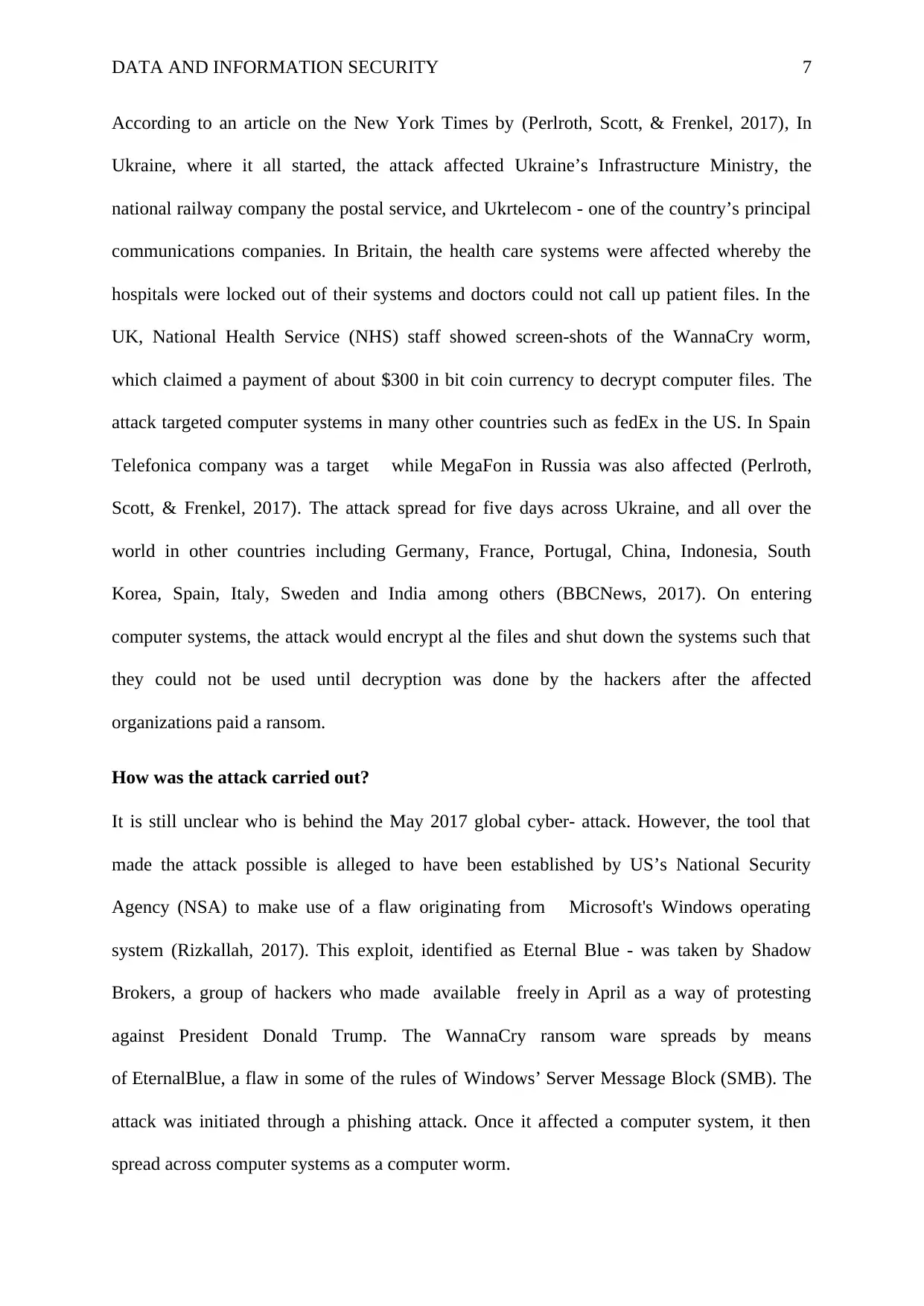
DATA AND INFORMATION SECURITY 7
According to an article on the New York Times by (Perlroth, Scott, & Frenkel, 2017), In
Ukraine, where it all started, the attack affected Ukraine’s Infrastructure Ministry, the
national railway company the postal service, and Ukrtelecom - one of the country’s principal
communications companies. In Britain, the health care systems were affected whereby the
hospitals were locked out of their systems and doctors could not call up patient files. In the
UK, National Health Service (NHS) staff showed screen-shots of the WannaCry worm,
which claimed a payment of about $300 in bit coin currency to decrypt computer files. The
attack targeted computer systems in many other countries such as fedEx in the US. In Spain
Telefonica company was a target while MegaFon in Russia was also affected (Perlroth,
Scott, & Frenkel, 2017). The attack spread for five days across Ukraine, and all over the
world in other countries including Germany, France, Portugal, China, Indonesia, South
Korea, Spain, Italy, Sweden and India among others (BBCNews, 2017). On entering
computer systems, the attack would encrypt al the files and shut down the systems such that
they could not be used until decryption was done by the hackers after the affected
organizations paid a ransom.
How was the attack carried out?
It is still unclear who is behind the May 2017 global cyber- attack. However, the tool that
made the attack possible is alleged to have been established by US’s National Security
Agency (NSA) to make use of a flaw originating from Microsoft's Windows operating
system (Rizkallah, 2017). This exploit, identified as Eternal Blue - was taken by Shadow
Brokers, a group of hackers who made available freely in April as a way of protesting
against President Donald Trump. The WannaCry ransom ware spreads by means
of EternalBlue, a flaw in some of the rules of Windows’ Server Message Block (SMB). The
attack was initiated through a phishing attack. Once it affected a computer system, it then
spread across computer systems as a computer worm.
According to an article on the New York Times by (Perlroth, Scott, & Frenkel, 2017), In
Ukraine, where it all started, the attack affected Ukraine’s Infrastructure Ministry, the
national railway company the postal service, and Ukrtelecom - one of the country’s principal
communications companies. In Britain, the health care systems were affected whereby the
hospitals were locked out of their systems and doctors could not call up patient files. In the
UK, National Health Service (NHS) staff showed screen-shots of the WannaCry worm,
which claimed a payment of about $300 in bit coin currency to decrypt computer files. The
attack targeted computer systems in many other countries such as fedEx in the US. In Spain
Telefonica company was a target while MegaFon in Russia was also affected (Perlroth,
Scott, & Frenkel, 2017). The attack spread for five days across Ukraine, and all over the
world in other countries including Germany, France, Portugal, China, Indonesia, South
Korea, Spain, Italy, Sweden and India among others (BBCNews, 2017). On entering
computer systems, the attack would encrypt al the files and shut down the systems such that
they could not be used until decryption was done by the hackers after the affected
organizations paid a ransom.
How was the attack carried out?
It is still unclear who is behind the May 2017 global cyber- attack. However, the tool that
made the attack possible is alleged to have been established by US’s National Security
Agency (NSA) to make use of a flaw originating from Microsoft's Windows operating
system (Rizkallah, 2017). This exploit, identified as Eternal Blue - was taken by Shadow
Brokers, a group of hackers who made available freely in April as a way of protesting
against President Donald Trump. The WannaCry ransom ware spreads by means
of EternalBlue, a flaw in some of the rules of Windows’ Server Message Block (SMB). The
attack was initiated through a phishing attack. Once it affected a computer system, it then
spread across computer systems as a computer worm.
Paraphrase This Document
Need a fresh take? Get an instant paraphrase of this document with our AI Paraphraser
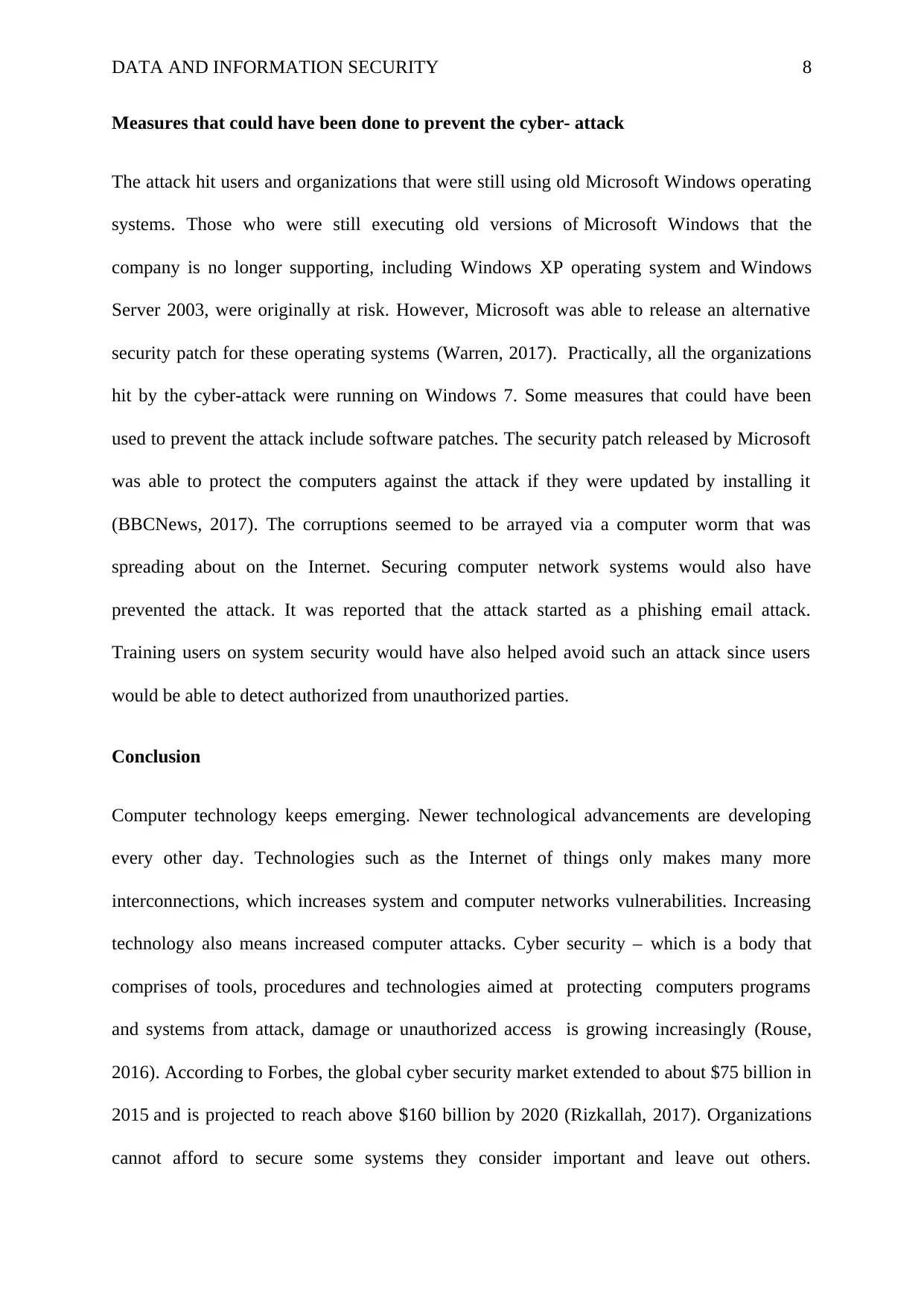
DATA AND INFORMATION SECURITY 8
Measures that could have been done to prevent the cyber- attack
The attack hit users and organizations that were still using old Microsoft Windows operating
systems. Those who were still executing old versions of Microsoft Windows that the
company is no longer supporting, including Windows XP operating system and Windows
Server 2003, were originally at risk. However, Microsoft was able to release an alternative
security patch for these operating systems (Warren, 2017). Practically, all the organizations
hit by the cyber-attack were running on Windows 7. Some measures that could have been
used to prevent the attack include software patches. The security patch released by Microsoft
was able to protect the computers against the attack if they were updated by installing it
(BBCNews, 2017). The corruptions seemed to be arrayed via a computer worm that was
spreading about on the Internet. Securing computer network systems would also have
prevented the attack. It was reported that the attack started as a phishing email attack.
Training users on system security would have also helped avoid such an attack since users
would be able to detect authorized from unauthorized parties.
Conclusion
Computer technology keeps emerging. Newer technological advancements are developing
every other day. Technologies such as the Internet of things only makes many more
interconnections, which increases system and computer networks vulnerabilities. Increasing
technology also means increased computer attacks. Cyber security – which is a body that
comprises of tools, procedures and technologies aimed at protecting computers programs
and systems from attack, damage or unauthorized access is growing increasingly (Rouse,
2016). According to Forbes, the global cyber security market extended to about $75 billion in
2015 and is projected to reach above $160 billion by 2020 (Rizkallah, 2017). Organizations
cannot afford to secure some systems they consider important and leave out others.
Measures that could have been done to prevent the cyber- attack
The attack hit users and organizations that were still using old Microsoft Windows operating
systems. Those who were still executing old versions of Microsoft Windows that the
company is no longer supporting, including Windows XP operating system and Windows
Server 2003, were originally at risk. However, Microsoft was able to release an alternative
security patch for these operating systems (Warren, 2017). Practically, all the organizations
hit by the cyber-attack were running on Windows 7. Some measures that could have been
used to prevent the attack include software patches. The security patch released by Microsoft
was able to protect the computers against the attack if they were updated by installing it
(BBCNews, 2017). The corruptions seemed to be arrayed via a computer worm that was
spreading about on the Internet. Securing computer network systems would also have
prevented the attack. It was reported that the attack started as a phishing email attack.
Training users on system security would have also helped avoid such an attack since users
would be able to detect authorized from unauthorized parties.
Conclusion
Computer technology keeps emerging. Newer technological advancements are developing
every other day. Technologies such as the Internet of things only makes many more
interconnections, which increases system and computer networks vulnerabilities. Increasing
technology also means increased computer attacks. Cyber security – which is a body that
comprises of tools, procedures and technologies aimed at protecting computers programs
and systems from attack, damage or unauthorized access is growing increasingly (Rouse,
2016). According to Forbes, the global cyber security market extended to about $75 billion in
2015 and is projected to reach above $160 billion by 2020 (Rizkallah, 2017). Organizations
cannot afford to secure some systems they consider important and leave out others.
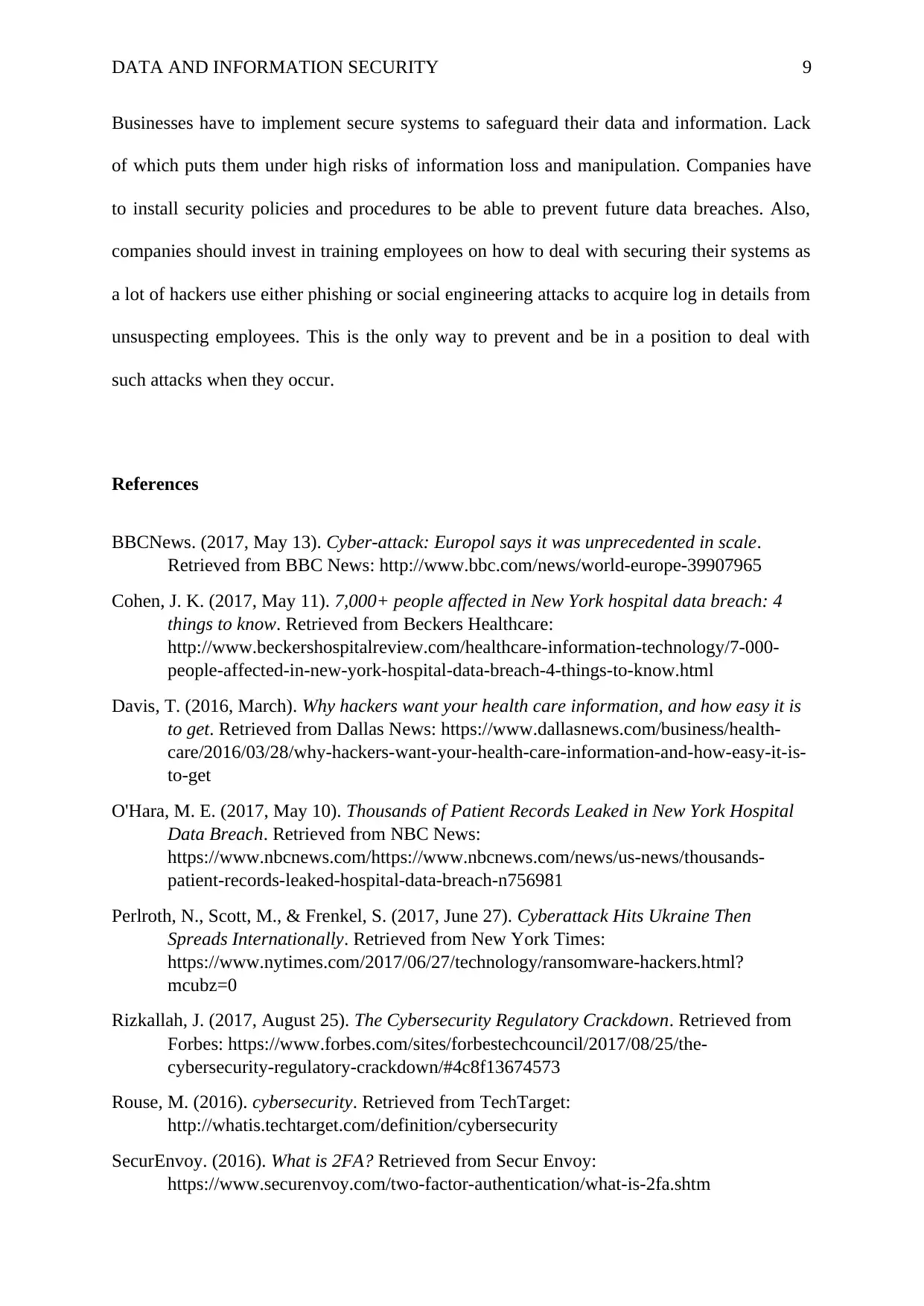
DATA AND INFORMATION SECURITY 9
Businesses have to implement secure systems to safeguard their data and information. Lack
of which puts them under high risks of information loss and manipulation. Companies have
to install security policies and procedures to be able to prevent future data breaches. Also,
companies should invest in training employees on how to deal with securing their systems as
a lot of hackers use either phishing or social engineering attacks to acquire log in details from
unsuspecting employees. This is the only way to prevent and be in a position to deal with
such attacks when they occur.
References
BBCNews. (2017, May 13). Cyber-attack: Europol says it was unprecedented in scale.
Retrieved from BBC News: http://www.bbc.com/news/world-europe-39907965
Cohen, J. K. (2017, May 11). 7,000+ people affected in New York hospital data breach: 4
things to know. Retrieved from Beckers Healthcare:
http://www.beckershospitalreview.com/healthcare-information-technology/7-000-
people-affected-in-new-york-hospital-data-breach-4-things-to-know.html
Davis, T. (2016, March). Why hackers want your health care information, and how easy it is
to get. Retrieved from Dallas News: https://www.dallasnews.com/business/health-
care/2016/03/28/why-hackers-want-your-health-care-information-and-how-easy-it-is-
to-get
O'Hara, M. E. (2017, May 10). Thousands of Patient Records Leaked in New York Hospital
Data Breach. Retrieved from NBC News:
https://www.nbcnews.com/https://www.nbcnews.com/news/us-news/thousands-
patient-records-leaked-hospital-data-breach-n756981
Perlroth, N., Scott, M., & Frenkel, S. (2017, June 27). Cyberattack Hits Ukraine Then
Spreads Internationally. Retrieved from New York Times:
https://www.nytimes.com/2017/06/27/technology/ransomware-hackers.html?
mcubz=0
Rizkallah, J. (2017, August 25). The Cybersecurity Regulatory Crackdown. Retrieved from
Forbes: https://www.forbes.com/sites/forbestechcouncil/2017/08/25/the-
cybersecurity-regulatory-crackdown/#4c8f13674573
Rouse, M. (2016). cybersecurity. Retrieved from TechTarget:
http://whatis.techtarget.com/definition/cybersecurity
SecurEnvoy. (2016). What is 2FA? Retrieved from Secur Envoy:
https://www.securenvoy.com/two-factor-authentication/what-is-2fa.shtm
Businesses have to implement secure systems to safeguard their data and information. Lack
of which puts them under high risks of information loss and manipulation. Companies have
to install security policies and procedures to be able to prevent future data breaches. Also,
companies should invest in training employees on how to deal with securing their systems as
a lot of hackers use either phishing or social engineering attacks to acquire log in details from
unsuspecting employees. This is the only way to prevent and be in a position to deal with
such attacks when they occur.
References
BBCNews. (2017, May 13). Cyber-attack: Europol says it was unprecedented in scale.
Retrieved from BBC News: http://www.bbc.com/news/world-europe-39907965
Cohen, J. K. (2017, May 11). 7,000+ people affected in New York hospital data breach: 4
things to know. Retrieved from Beckers Healthcare:
http://www.beckershospitalreview.com/healthcare-information-technology/7-000-
people-affected-in-new-york-hospital-data-breach-4-things-to-know.html
Davis, T. (2016, March). Why hackers want your health care information, and how easy it is
to get. Retrieved from Dallas News: https://www.dallasnews.com/business/health-
care/2016/03/28/why-hackers-want-your-health-care-information-and-how-easy-it-is-
to-get
O'Hara, M. E. (2017, May 10). Thousands of Patient Records Leaked in New York Hospital
Data Breach. Retrieved from NBC News:
https://www.nbcnews.com/https://www.nbcnews.com/news/us-news/thousands-
patient-records-leaked-hospital-data-breach-n756981
Perlroth, N., Scott, M., & Frenkel, S. (2017, June 27). Cyberattack Hits Ukraine Then
Spreads Internationally. Retrieved from New York Times:
https://www.nytimes.com/2017/06/27/technology/ransomware-hackers.html?
mcubz=0
Rizkallah, J. (2017, August 25). The Cybersecurity Regulatory Crackdown. Retrieved from
Forbes: https://www.forbes.com/sites/forbestechcouncil/2017/08/25/the-
cybersecurity-regulatory-crackdown/#4c8f13674573
Rouse, M. (2016). cybersecurity. Retrieved from TechTarget:
http://whatis.techtarget.com/definition/cybersecurity
SecurEnvoy. (2016). What is 2FA? Retrieved from Secur Envoy:
https://www.securenvoy.com/two-factor-authentication/what-is-2fa.shtm
⊘ This is a preview!⊘
Do you want full access?
Subscribe today to unlock all pages.

Trusted by 1+ million students worldwide
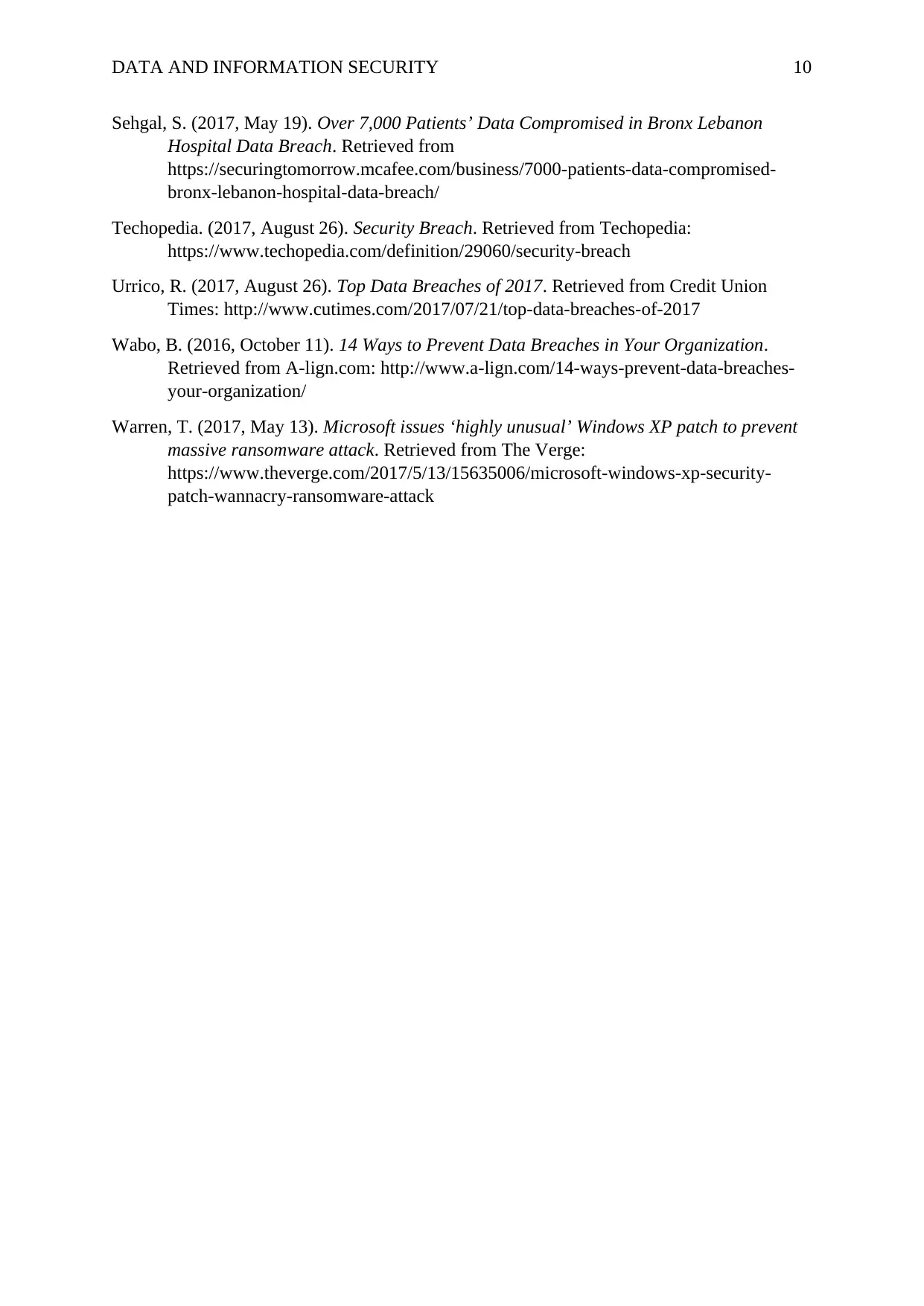
DATA AND INFORMATION SECURITY 10
Sehgal, S. (2017, May 19). Over 7,000 Patients’ Data Compromised in Bronx Lebanon
Hospital Data Breach. Retrieved from
https://securingtomorrow.mcafee.com/business/7000-patients-data-compromised-
bronx-lebanon-hospital-data-breach/
Techopedia. (2017, August 26). Security Breach. Retrieved from Techopedia:
https://www.techopedia.com/definition/29060/security-breach
Urrico, R. (2017, August 26). Top Data Breaches of 2017. Retrieved from Credit Union
Times: http://www.cutimes.com/2017/07/21/top-data-breaches-of-2017
Wabo, B. (2016, October 11). 14 Ways to Prevent Data Breaches in Your Organization.
Retrieved from A-lign.com: http://www.a-lign.com/14-ways-prevent-data-breaches-
your-organization/
Warren, T. (2017, May 13). Microsoft issues ‘highly unusual’ Windows XP patch to prevent
massive ransomware attack. Retrieved from The Verge:
https://www.theverge.com/2017/5/13/15635006/microsoft-windows-xp-security-
patch-wannacry-ransomware-attack
Sehgal, S. (2017, May 19). Over 7,000 Patients’ Data Compromised in Bronx Lebanon
Hospital Data Breach. Retrieved from
https://securingtomorrow.mcafee.com/business/7000-patients-data-compromised-
bronx-lebanon-hospital-data-breach/
Techopedia. (2017, August 26). Security Breach. Retrieved from Techopedia:
https://www.techopedia.com/definition/29060/security-breach
Urrico, R. (2017, August 26). Top Data Breaches of 2017. Retrieved from Credit Union
Times: http://www.cutimes.com/2017/07/21/top-data-breaches-of-2017
Wabo, B. (2016, October 11). 14 Ways to Prevent Data Breaches in Your Organization.
Retrieved from A-lign.com: http://www.a-lign.com/14-ways-prevent-data-breaches-
your-organization/
Warren, T. (2017, May 13). Microsoft issues ‘highly unusual’ Windows XP patch to prevent
massive ransomware attack. Retrieved from The Verge:
https://www.theverge.com/2017/5/13/15635006/microsoft-windows-xp-security-
patch-wannacry-ransomware-attack
1 out of 10
Related Documents
Your All-in-One AI-Powered Toolkit for Academic Success.
+13062052269
info@desklib.com
Available 24*7 on WhatsApp / Email
![[object Object]](/_next/static/media/star-bottom.7253800d.svg)
Unlock your academic potential
Copyright © 2020–2025 A2Z Services. All Rights Reserved. Developed and managed by ZUCOL.



